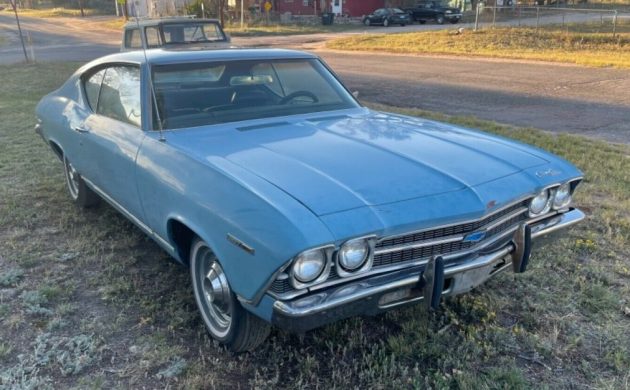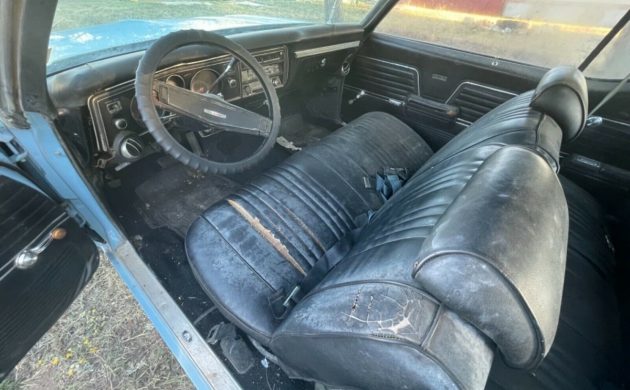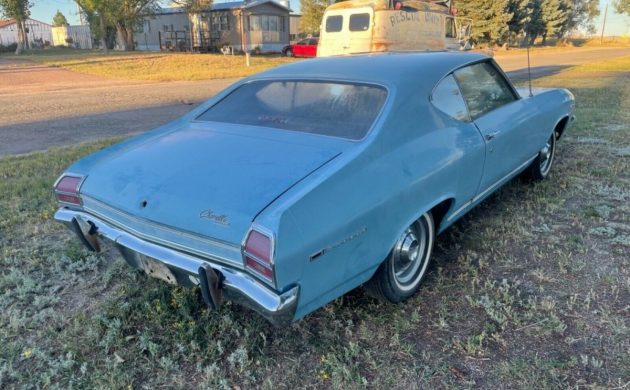Sometimes it can be the simplest of problems that can be the catalyst for a classic car to find itself relegated to a barn or shed for years. That would appear to be the case with this 1969 Chevrolet Chevelle Malibu because a transmission gremlin has forced this otherwise healthy classic off our roads. It has little rust, which makes it a hot prospect as a project car. The buyer might choose a faithful restoration, although an SS clone could be a challenge worth accepting. If you like what you see, you will find the Chevelle located in Peyton, Colorado, and listed for sale here on eBay. The owner has set the BIN at $12,500, and with 106 people watching the listing, it seems that a few people like what they see.
It almost seems like there is an air of inevitably that Malibu projects from this era will have some significant rust for the buyer to tackle. However, things might not be that bad in this case. The owner admits that there is rust present in the trunk extensions, but it seems that this might be the extent of the significant problems. He indicates that the floors and trunk pan are solid, and if the frame is in a similar state, potential buyers could be onto a winner with this classic. Externally, I can’t spot any further rust, but there are a few other factors to consider. The owner treated the car to a repaint during the 1980s in its original Glacier Blue. This looks tired today, and there’s also Bondo falling out in some spots. That might warrant further investigation, but it is an indication that the buyer will have some preparatory work to perform before they consider a fresh coat of paint. Potentially the biggest issue that the buyer will face is the substantial hole in the roof. Glass aftermarket sunroofs were big business in the 1970s and 1980s, and it appears that this Malibu received one. These seemed like a great idea at the time, but due to the universal nature of their fitment, more than a few leaked like a sieve. It doesn’t appear that this one has suffered that fate, but I would never rule it out. That leaves the buyer with a couple of choices. They could remove the sunroof and weld in a patch to replace it. That would be a big job, and it may be best handled by a professional if a high-quality finish is desired. The other choice would be to leave well-enough alone and continue to monitor it carefully for leaks. As much as I am a fan of originality, the latter path may be the most sensible for the buyer to follow from a cost perspective.
Lifting the hood reveals a healthy 307ci V8, while the owner also ticked the boxes beside the Powerglide transmission and power steering. The 307 didn’t make the Malibu the most powerful beast on the planet, although it still gave buyers 200hp at their disposal. It made the car capable of covering the ¼ mile in 17.2 seconds, which was a respectable figure at the time. This is where we reach the issue that has seen this classic parked. While its V8 is in good health, the owner says that the Powerglide has given up the ghost. It isn’t clear when this happened, but it seems that a rebuild could be on the cards. However, the buyer might also decide that they want an SS clone, which would provide the opportunity to slot a different drivetrain under that solid body. It would be a matter of personal preference, but I think the odds are stacked in favor of that being the fate of this Chevy.
When we start to compile a list of trim items that the buyer would need to make this Malibu’s interior sparkle, that list gets pretty long. It includes a front seatcover, a carpet set, a headliner, a dash pad, and potentially, a set of door trims. Sourcing those parts individually would be an easy undertaking, but when you start to tally the prices, the final figure comes close to what that person would pay for a complete trim kit. That makes this the most financially sensible option and ensures that the buyer wouldn’t have any mismatches between older and newer upholstery. A kit retails for around $2,000, but it is a one-off expense that would return this car to a factory-fresh state. The owner chose to slap down an additional $376 above the sticker price to equip this Chevelle with air conditioning. This remains intact, although the compressor is sitting in the trunk.
For potential buyers, this 1969 Chevelle Malibu offers several options that are worth considering. It is a solid vehicle with only minor rust issues, and its complete nature would make it a prime candidate for a faithful restoration. However, its existing mechanical issue may be sufficient to justify updating the drivetrain to something more modern or potent. The ready availability and affordability of the parts required for such a build make that option pretty attractive. Which path would you follow, and are you tempted to pursue this one further? With the number of people watching this listing, you may need to act quickly to park this classic in your workshop.






I’ve never figured out why gm got rid of the 307 only to debut the 305 small block just several years later. Since both are essentially the same engine, being a SBC, what’s the real difference or advantage of one over the other?
You might as well ask why it came in 262, 265, and 267 CI versions.
The 307 was a 327 block with a 283 crank, giving it a long stroke and a poor bore to stroke ratio. The long stroke resulted in a small displacement engine, that didn’t like to rev. Not a good combination. The 307 replaced the 283 in 68, and was dropped in 73.
The 305 came out in 76, and was cheaper to make because it shared it’s crank with the 350. The 350 crank gave it a slightly better bore to stroke ratio than the 307.
The 262 was introduced in 75 as a small V8 to power the Monza. It was basically a performance upgrade over the Monza’s base 4 cylinder, and was a lighter, smoother running, small displacement alternative to putting a straight 6 in those cars. It was dropped in 77, when the 305 came out.
The 267 came out in 79. Like the 305, the 267 used the same crank as the 350, giving it a nearly square bore to stroke ratio. It was designed strictly to be a small displacement, emission friendly, fuel efficient V8 engine.
1955’s 265 became a 283 in 57, the 283 was replaced in 68 by the 283, and the 327 was replaced in 67 by the 350, all for the same reason, in the 50’s and 60’s displacement was king, and engines always kept getting bigger.
I dont know enough but I always thought the 307 was a 283 block with a longer stroke from a 327. Not a destroked 327, which would be, the Z28 302. Too many different bore and stroke conbinations to remember.
You are almost right except the 327/283 was actually the 302 used in the original Z28
Thanks. Never could figure out the differences, although my memories of mid 70s 350s is that they were dogs. The 327s always seemed to rev better and run better than the 350s. My folks have a 57 bel air with a 283 that to me seems superior to the 305. I’m more knowledgeable about fords but have a 305 in my 83 z28 and its definitely not powerful. 350 in my 84 corvette and it wont set the world on fire either. 454 in my 73 c10 is the best running of the bunch although I’m aware that’s a completely different engine, being a big block.
$12500? For a plain Malibu without any options? That needs everything? Hard pass.
It has A/C
I say this time and time again, but the 1st thing most gearheads think of when a ’69 Chevelle is mentioned, big block, wheel standing monsters come to mind, but, those cars were few and far between. The great majority of ’69 Chevelles looked just like this ( that became big block monsters later). Secretaries, librarians, that hippy, dippy high school single female art teacher you always had a hankerin’ for,, all drove mundane Chevelles. It was usually the car their dad recommended. Living here in Colorado, there seems to be a never ending supply of these types of cars. I bet garages are full of them, and usually after the owner dies, they come to light. With the computer today, it’s getting harder and harder to be the one that “found it”, and these greedy bastxxx’s, want a hefty premium for that, as shown. This person scarfed this car up at an estate sale for a $1,000 bucks, I bet. It’s all about the right place at the right time.
Yesterday’s $1250.00 is today’s $12,500.00…
The repaint appears to be hiding some previous work, but at this price the car won’t find a home anyhow.
It sold, and fast.
There is no way to know what the seller paid, to arbitrarily assign an unrealistically low purchase price of $1,000 or $1,250 is laughable and designed to push a narrative. Late-60’s Chevelle’s in this condition haven’t been selling for that price for a couple of decades, even from a naive owners. As you point out, someone saw the value this car as fair enough that they struck a deal, without regards to the opinions expressed on this site.
Steve R
Sunroof kinda ruins it, along with the whitewalls but a ’69 Chevelle two door is a sporty looking car no matter what…even this grocery getting pick up the kids version here. No SS clone needed for better looks,
Just throw on some period correct mag wheels, modern(noisy) dual exhaust, and we’re almost enjoying high school again. No parts identifying stickers all over the glass though.
An older friend in high school, he was in the class of ’73, had a plain Chevelle like this with a V8 and 4 speed. It was jacked up, had traction bars and Cragars, all typical for the era around here. It was black with a white roof. You know how sometimes a guy is defined by his car? His nickname was ‘skunk’ and it stuck, even to this day, lol. He also had a Honda CL160 with ‘Snuff-r-not’s’. I remember both vehicles quite well. He married one of my classmates, class of ’75 in 1974 and they’re still together, the way it should be.
@ Bick Banter
There’s a sucker born every minute. In this case a sucker with too much money
That’s right Angel, though in some way, we should marvel and respect that we live in a society which actually created enough wealth for individual people to blow this kind of money on these things. In many countries, this is 3 years’ salary for an average family. And somebody thought nothing of blowing that on an old Chevy that needs a lot of work. I’m not trying to be smart or nasty. I am seriously amazed.
But meanwhile, they’ll probably end up stuck with an asset worth less than what they paid for in about 5 years. Economies are fickle.
After market sunroof=Hard “no”
In the early 60’s it seemed that many kids in HS had 55 Chevys with 283s that were bored out to 301s. Most of us wanted one because the light 55-56 chevys would really run compared to the competition then, especially if you put a 3.73 or 4.11 rear in them. These 301s were high reving engines with their short stroke. This is really the same displacement as the 302s that later showed up in the Z28s.
Looks like the sale fell through, and its back up for sale:
https://www.ebay.com/itm/133888684474?ViewItem=&item=133888684474&vxp=mtr